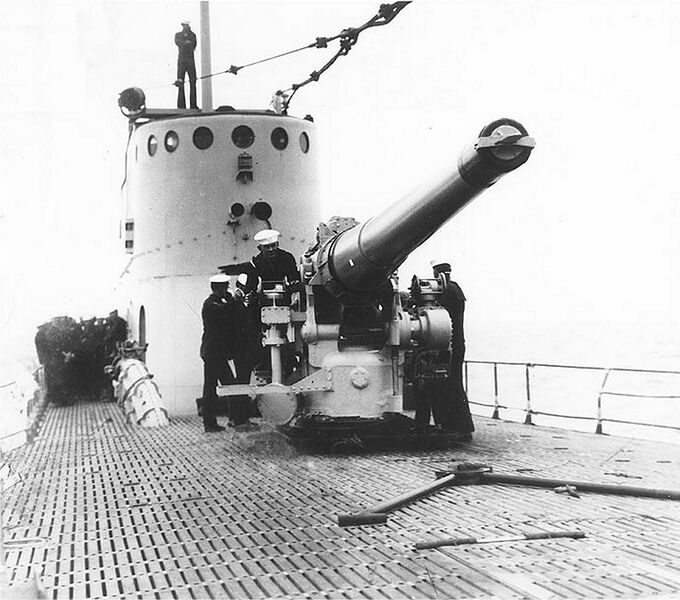V-4
Design, Construction, and Naming Notes
V-4 was a giant. At 381 feet long and a displacement of 3,046 tons submerged her size would not be exceeded by a USN submarine until the nuclear-powered USS Triton (SSRN-586) of 1955. Her great size was dictated by the need to achieve long range. Only a very large submarine would be able to carry the fuel necessary to span the Atlantic and Pacific in search of the enemy's merchantmen. V-4 was also to be equipped with the largest caliber gun ever installed on a USN submarine, two 6"/53 caliber Mk 17 guns, one forward and one aft of the conning tower fairwater in open mounts.
Her great range enabled V-4 to go to an enemy's coastline and lay an effective minefield. The minelaying gear was unique to the boat, and it occupied the after end. Space was provided for sixty huge Mk 11 mines and specialized, automatic, hydraulically operated handling gear. The mines were launched from two large aft facing tubes, and the mines could be laid while the boat was completely submerged. She also was equipped with four 21-inch torpedo tubes forward, with a capacity of 20 Mk 14 torpedoes.
During the construction of V-4, the Navy began to experiment with welding. This new and as-yet unproven process was used in certain non-critical areas like superstructure framing, pipe brackets, and interior deck joinery. The remainder of her construction was traditional riveting. The Navy's attitude towards this potential paradigm shift in submarine construction remained rather tepid for the next six years as they gained confidence in this radical change, and as they worked out labor and organizational issues. Please read this article that deals with this important subject.
All of the V-boats, but especially the huge V-4, suffered from an underdeveloped diesel engine industrial base in the United States. The industry was still in its infancy in the U.S., and the Navy was forced to rely on license-built derivations of German MAN company designs. The V-4 was definitely underpowered, with her plant consisting of two direct drive 1,400 hp BuEng/MAN main propulsion diesels, and one 450 hp BuEng/MAN generator engine. The Navy specified 15 knots for this boat, and she struggled to make that.
Once commissioned the Navy got a chance to try her out. The minelaying gear proved to be finicky and difficult to maintain and the minelaying role was ultimately unpopular with the force. V-4 was a slow diver with sluggish underwater maneuverability and her engines were not reliable. Despite this, the boat provided good service to the fleet during the 1930's. On February 19, 1931 she was renamed Argonaut. Noted historian John D. Alden maintains that she was never officially redesignated into the general SS series (her hull number would have been 166), and has stated that she remained designated SM-1 until September 22, 1942. However, the authors have uncovered photos of her from the late 1930's that show her with 166 painted on the side of her fairwater. This would not have been done without official approval, and therefore the official redesignation is likely true. It is possible that the otherwise meticulous Alden simply missed the document concerning her redesignation during his research, or it had been destroyed or lost and was not available to him.
By the start of the war she was worn out and in need of a thorough overhaul. An early 1942 yard period at Mare Island completely reconditioned the boat, giving her new General Motors engines, air conditioning, a torpedo data computer, radar, longer periscopes, and two aft facing topside torpedo tubes. At that time it was felt that she could still prove useful as a minelayer so her aft minelaying gear was retained. She arrived back in Pearl Harbor in early August just in time to be assigned to the Makin Island raid, where it was realized her great size would enable her to carry dozens of Marines. The Pearl Harbor Navy Yard hurriedly stripped most of the mine handling gear from the after rooms and installed numerous bunks for the Marines. This capability gave her a new lease on life and on September 22, 1942 she was redesignated APS-1 (Auxiliary Transport Submarine) to reflect this new mission.
The needs of the war effort forced the Navy to send her on general patrol duties, where her great size and barge-like maneuverability placed her at a disadvantage when dealing with the nimble Japanese destroyers. She made several war patrols before being caught by an IJN anti-submarine force off New Britain. She was sunk in battle in a combined depth charge and gunnery attack. 105 officers and men remain on eternal patrol.
Note: At the start of the war, the Navy had approximately 200 Mk 11 mines in their inventory, mines that had been specifically designed for this boat. Argonaut never laid a minefield in wartime, and what became of the unique Mk 11 mines is not known at this time. See this page for more information on this subject.
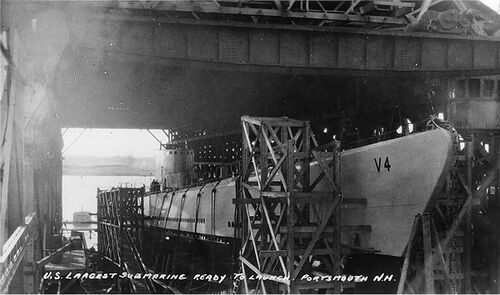
U.S. Navy photo
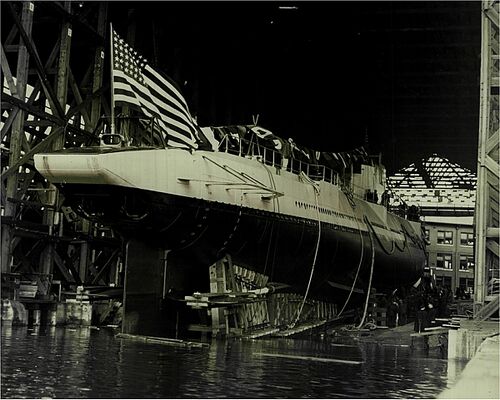
U.S. Navy photo
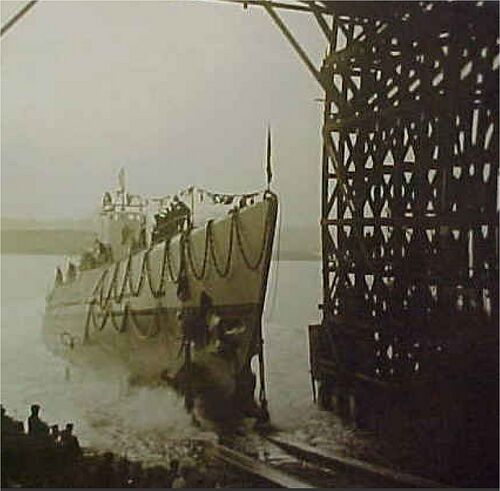
Photo courtesy of Navsource.org and the Boston Herald-Traveler
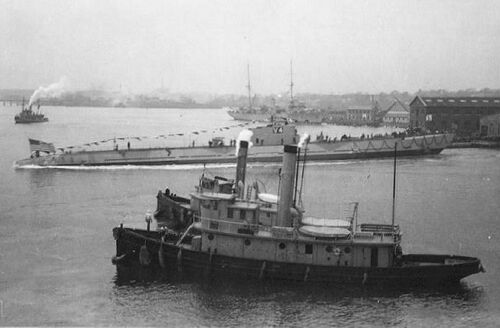
U.S. Navy photo
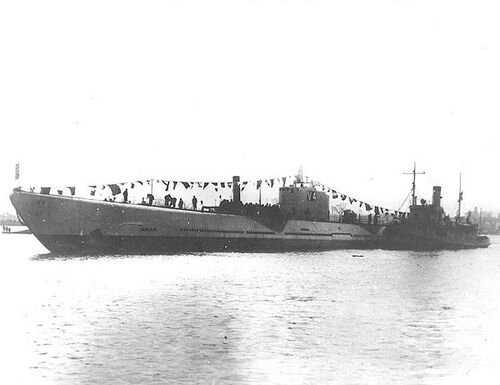
U.S. Navy photo
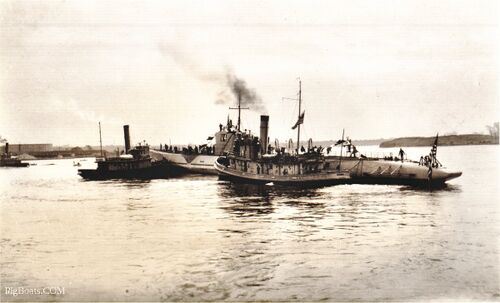
A number of interesting things are seen and happening in this photo. The launch is complete and the signal flags are coming down. The flags forward of the conning tower are being gathered up. The after string of flags is being loosened. A Bi-pod of boards supported the after string. A man has climbed to a cross brace to free them. A man stands behind him to steady him. A Chief or Officer is on the stern inspecting and ensuring that all is satisfactory.
The dark triangle seen between the tugs is the forward gun sponson. There is a similar one behind the conning tower hidden by the Mohave. The Mohave itself has just applied forward thrust to is propeller as evidenced by the wash seen at her stern. The white "splash" seen at the waterline at the side of Mohave is the outlet for the cooling water for the tugs' boiler.
The tug all the way to the left is taking charge of the building cradle seen floating next to it. A crew in a small boat is assisting.
Photo in the private collection of Ric Hedman
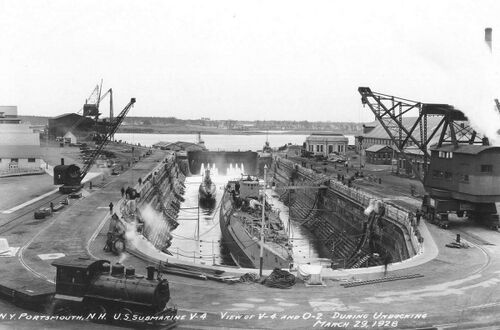
U.S. Navy photo
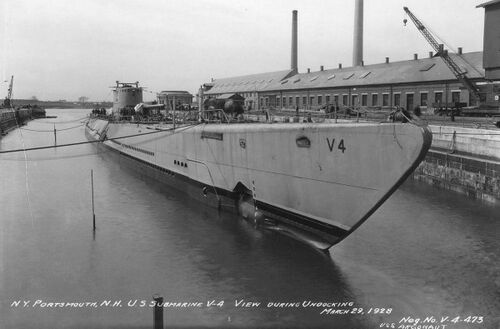
U.S. Navy photo

U.S. Navy photo
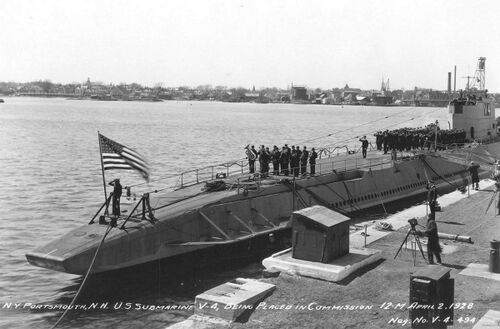
The notch in the edge of the deck on the starboard side was for a communications mast that would fold down into the notch. The mast is not yet installed in this photo. There is a similar notch for another mast in the edge of the deck forward of the forward deck gun.
U.S. Navy photo
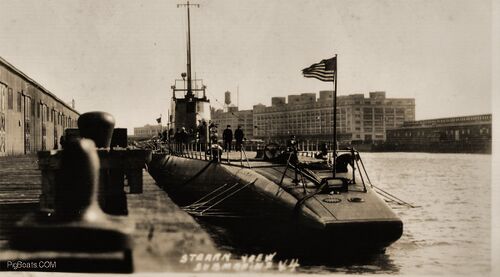
Photo in the private collection of Ric Hedman
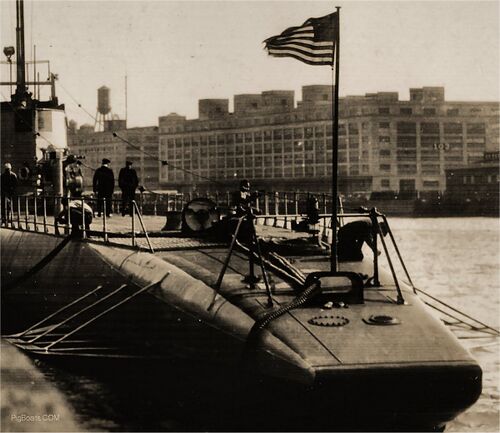
Photo in the private collection of Ric Hedman
Sea trials, June, 1928
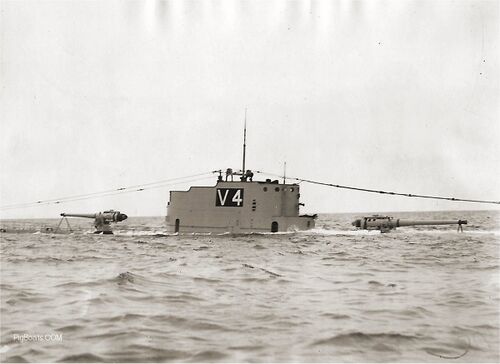
Her gun deck with her two 6"/53 caliber guns is just awash and the conning tower fairwater accesses are filling with water. The little splash of water seen just to the right of the forward fairwater access is coming from the ammunition hoist as it goes under water.
The short periscope at the front of the conning tower is the #1 periscope. It is offset to starboard by four feet off the center line (note its location in subsequent photos below) and is a short 'scope to be used before surfacing to check for obstacles. This periscope was later removed as unnecessary. The submarine had two centerline mounted regular periscopes that gave full visibility. These periscopes were all raised by electric motors and used a chain drive like a motorcycle type chain. They were very noisy. If you get a chance to see the 1931 movie "Seas Beneath" you can see and hear them in operation plus see some interior images of the submarine.
The ship's whistle can be seen sticking out at the front of the fairwater midway between the step and the top.
Photo in the private collection of Ric Hedman.
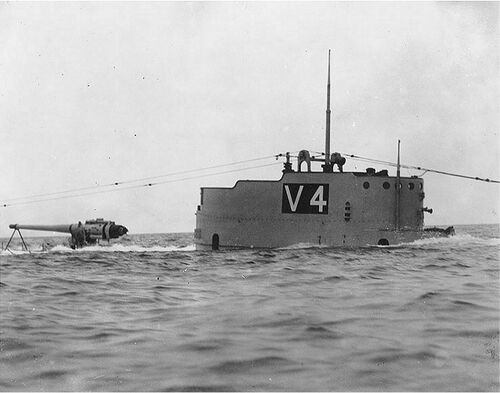
U.S. Navy photo
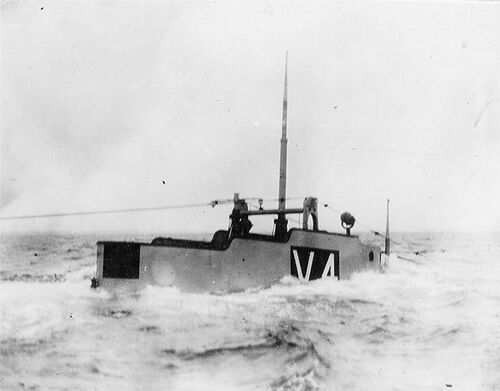
U.S. Navy photo

U.S. Navy photo

U.S. Navy photo
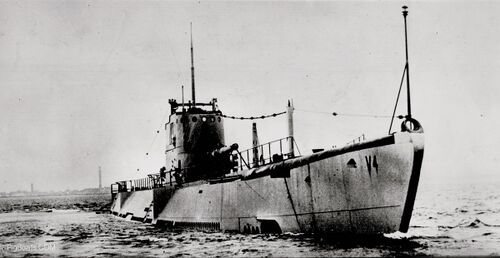
This photo was acquired from a German source and has a publication date of February 22, 1943. All notations are in German. That was four days before the Navy struck Argonaut's (V-4's) name from the Navy List as she had been sunk in action against the Japanese between New Britain and Bougainville, south of St. George's Channel on January 10, 1943.
Copy of a U.S. Navy photo acquired from a German WW II News Source in the Private Collection of Ric Hedman
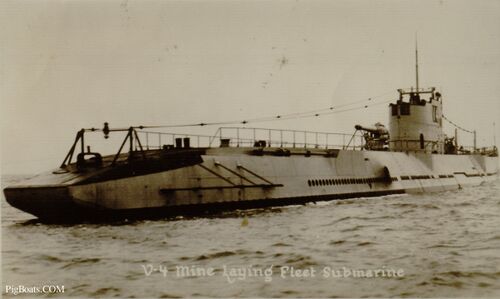
A starboard quarter view of V-4, likely taken during her June, 1928 sea trials. Large steel propeller guards jut out from her stern. These are intended to prevent damage to the propellers while maneuvering alongside a pier or while working with a tug. The recess in the top edge of her starboard side superstructure was for a fold down communications mast, which can be seen laying in the notch. V-4's two large minelaying tubes are just under the flat stern and out of view in this picture.
Photo in the private collection of Ric Hedman.
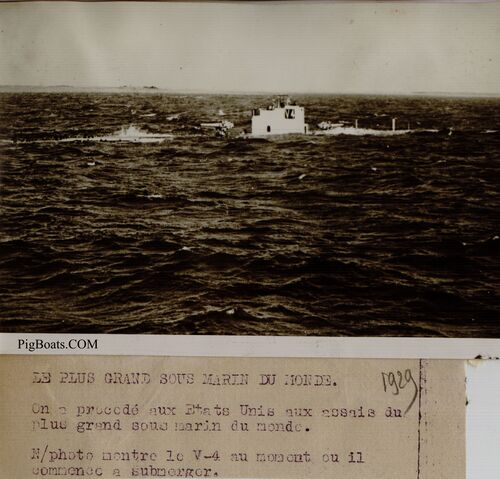
V-4 underway on trials, likely in the summer of 1928 in the waters off Cape Cod, MA. She is diving with her deck awash but with her guns and conning tower fairwater still above the surface. This photo was acquired by Ric Hedman and originally comes from a French newsreel service, even though it was likely taken by a USN photographer. The giant V-4 was making headlines around the world at the time and she was generating a lot of interest in international naval circles.
Photo in the private collection of Ric Hedman.
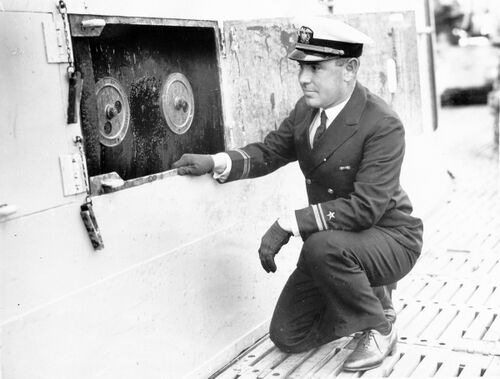
U.S. Navy photo
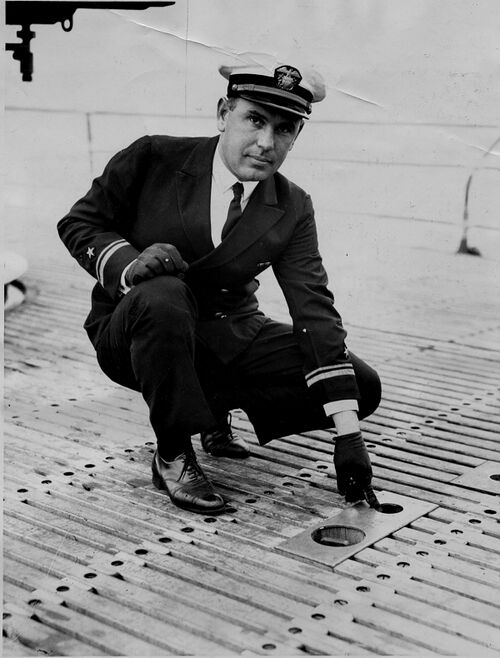
U.S. Navy photo
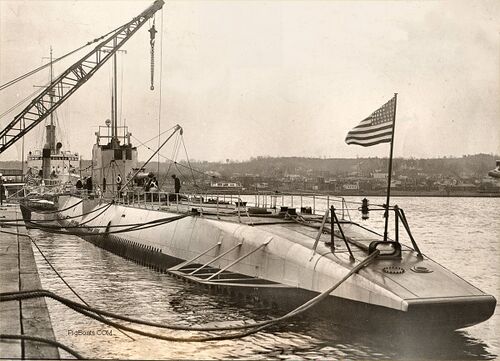
Just to the left of the door in the side of the fairwater is the after ammunition hoist. The shells for the guns were brought up from below this way. The shell and propellent powder bags were separate due to the weight involved. This made for easier and quicker handling.
the stern navigation light is mounted on the aft rail. The mooring lines are run through the after towing fairlead and lead to a set of bitts mounted on the aft deck.
Original News photo in the private collection of Ric Hedman.
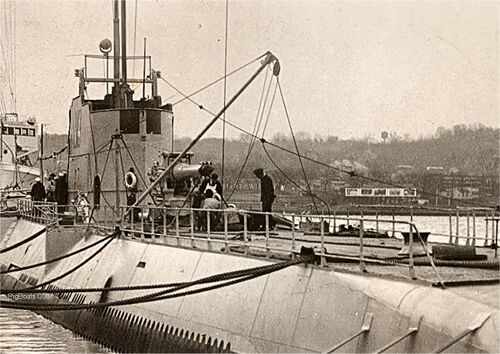
Original News photo in the private collection of Ric Hedman.
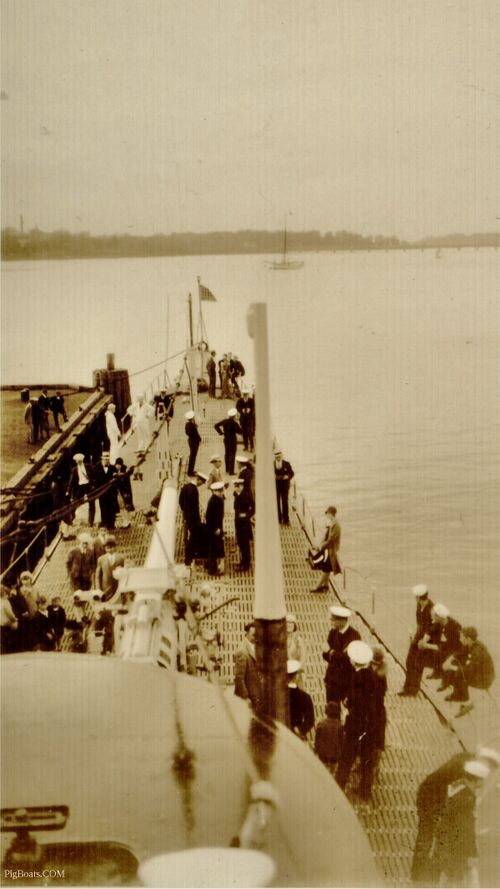
Original photo in the private collection of Ric Hedman
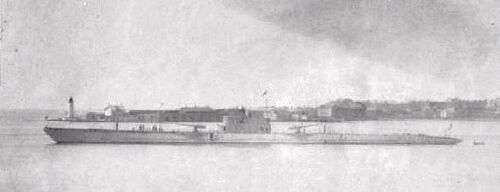
Photo in the private collection of Ric Hedman
Homeport shift to San Diego, 1929
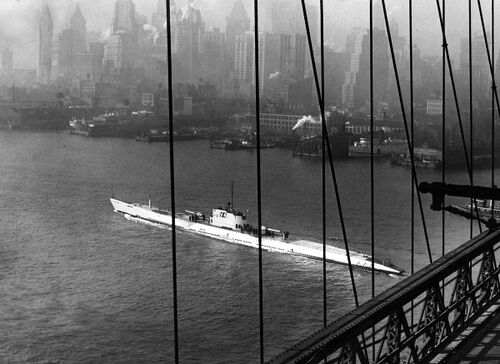
U.S. Navy photo

U.S. Navy photo
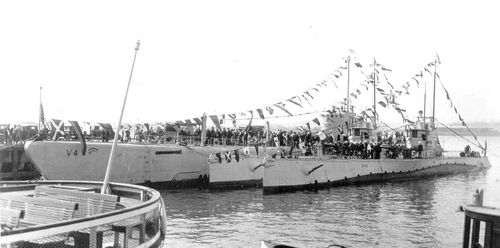
U.S. Navy photo
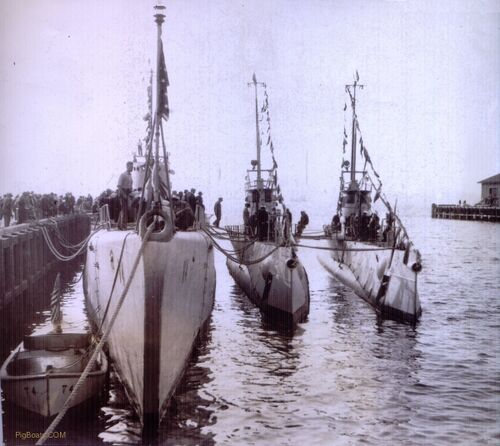
Seen in the lower left corner of the photo is one of the V-4's two launches. These were stored under the deck on the bow just aft of the forward torpedo room escape trunk. One was a rowing boat and the other a motorized launch. This is the motor launch.
Photo in the private collection of Ric Hedman
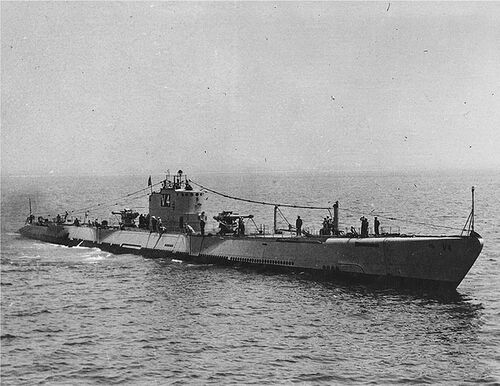
U.S. Navy photo
V-4 stars in the 1931 movie "The Seas Beneath"
PigBoats.COM has a 12 photo collection of stills and production shots from the movie. These came courtesy of Robert Morgan, and especially Mrs. Wendy Gulley of the Submarine Force Library & Museum in Groton, CT. All but one of the photos are from the personal collection of LCDR William Quigley, USN, the commanding officer of V-4 at the time, and may NOT be reused or reposted without the permission of the SFL&M.
Click here for this photo collection
1932 homeport shift to Pearl Harbor, Renaming, and World War II service
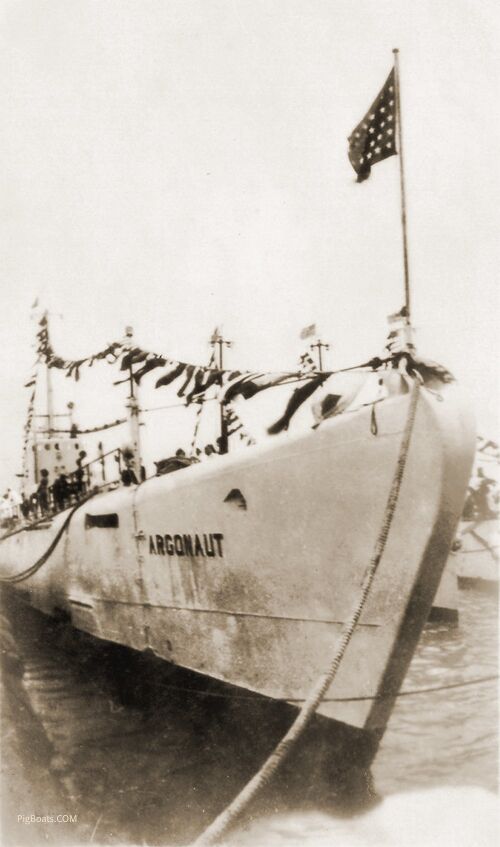
U.S. Navy photo
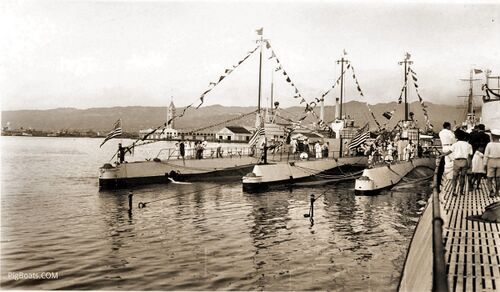
U.S. Navy photo
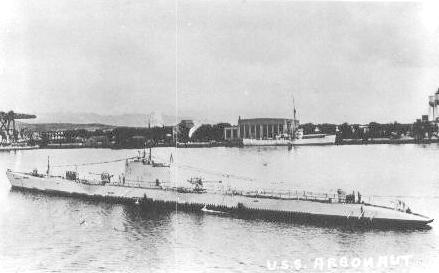
Photo in the private collection of Ric Hedman
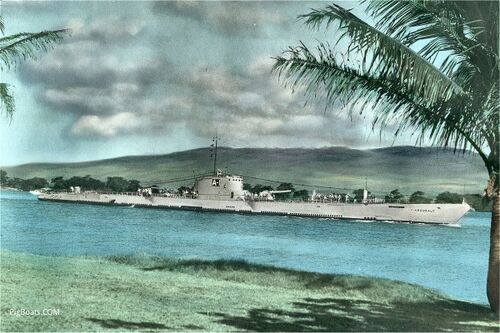
U.S. Navy photo
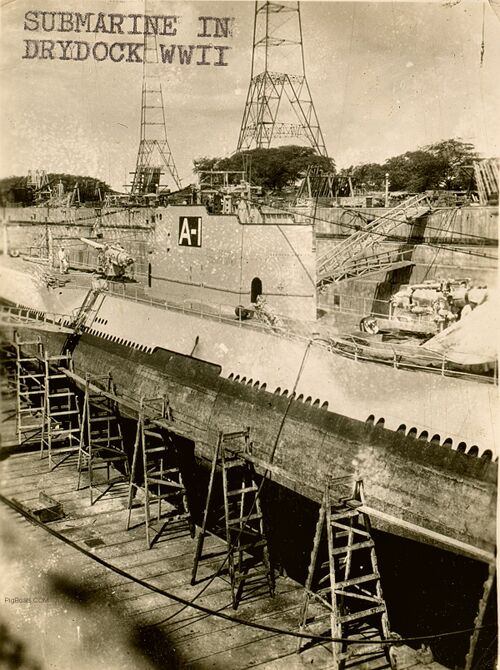
Photo in the private collection of Ric Hedman
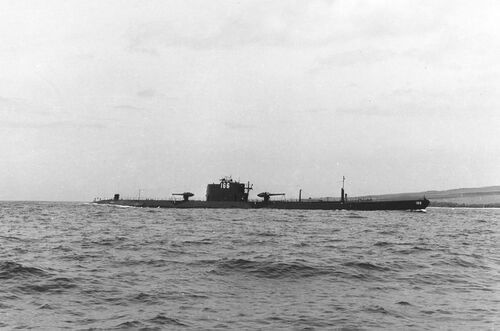
U.S. Navy photo courtesy Navsource.org

Photo from Life Magazine in the public domain.
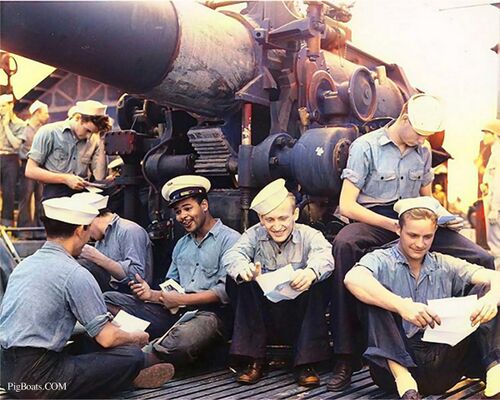
The African American Steward/Mess Attendant shown in this photo is Officer Steward 2nd Class Willie D. Thomas. He seems to have received a letter from home with a photo in it. Maybe of a wife or child. He appears to be talking with shipmate and fellow steward, Mess Attendant 1st Class Marcelino Taclob "Berg" Bergado. (back to camera)
The man seated in the center of the photo reading his letter with a big smile is Machinist's Mate 3rd Class William George Wehner from Mitchell, South Dakota. These were among those aboard the Argonaut when she was sunk on January 10, 1943. Rest in peace shipmates.
U.S. Navy photo now in the collections of the National Archives
Colorized by PigBoats.COM
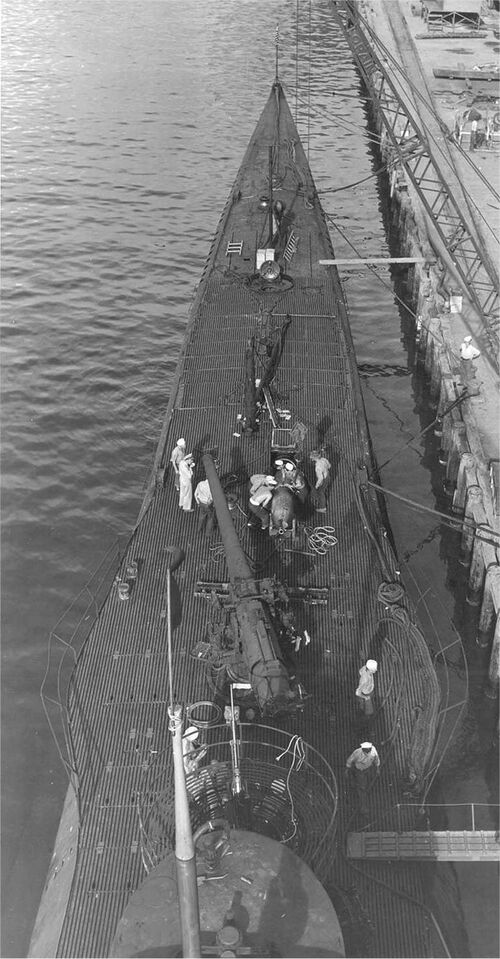
Please check out this page of Argonaut plans and blueprints. There you will see that her torpedo loading hatch was actually above the crew's mess space. Reload torpedoes would be winched down into this space, then laboriously moved forward into the torpedo room. It was also normal to stow at least two reload torpedoes on the starboard side of the crew's mess space.
U.S. Navy photo
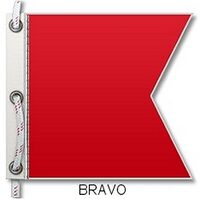
1943 World War II Loss
The following is from the Dictionary of American Naval Fighting Ships: " On 10 January 1943, Argonaut spotted a Japanese convoy of five freighters and their destroyer escorts. An Allied Army aircraft was by chance flying overhead and witnessed Argonaut's attack. (All the planes ammunition had been expended) Argonaut hit at least one of the destroyers with her torpedoes, and they promptly counterattacked. A crew member on board the plane saw Argonaut's bow suddenly break the water at an unusual angle. It was apparent that a depth charge had severely damaged the submarine. The enemy destroyers circling Argonaut fired shells into the boat from point blank range until she slipped below the waves. One hundred and five officers and men went down with the submarine. Her name was struck from the Navy list on 26 February 1943.
Argonaut was awarded two battle stars for her World War II service."'
The following are excerpts from the authoritative web page Combined Fleet (Nihon Kaigun). This site is maintained by Jon Parshall and Tony Tully, two highly respected historians and authorities on the IJN. On their Tabular Record of Movement (TROM) page for the destroyer Maikaze, we find the following entry concerning this action:
5-10 January (1943): IJN destroyer Maikaze TROM entry:
With Desdiv 17, escorted troop convoy (Operation 18: BRAZIL MARU, NICHIRYU MARU, CLYDE MARU, CHIFUKU MARU and MYOKO MARU, lifting units of 51st Division) from Rabaul to Lae and back. On 7-8 January NICHIRYU MARU and MYOKO MARU lost in bombing attacks. On 7 January rescued survivors of bombed transport NICHIRYU MARU; on 10 January sank USS ARGONAUT (APS-1) assisted by (destroyer) ISOKAZE and seaplane. Then to Shortlands on 13 January.
10 January (1943): IJN destroyer Isokaze TROM entry:
Action:
- 1025 A D3A of the 582nd Air Group reported a submerged submarine preparing to attack, and dropped three 60kg depth bombs. Destroyer MAIKAZE was led to it and dropped 95 depth-charges.
- 1045 The bow of the enemy submarine suddenly emerged from the sea. ISOKAZE joined MAIKAZE in shelling it till it sank. (This was a confirmed sinking and was USS ARGONAUT (APS-1) Convoy proceeded to Rabaul that same night.'
Argonaut was old, large, under powered, unwieldy submerged, and was unsuited for the type of action she was asked to perform. As a transport she performed well, but as an attack submarine she was totally unsuited for that final action. The U.S. command in Brisbane made the decision to send her out on this fateful patrol regardless.
Page created by:
Ric Hedman & David Johnston
1999 - 2023 - PigBoats.COM©
Mountlake Terrace, WA, Norfolk, VA
webmaster at pigboats dot com

